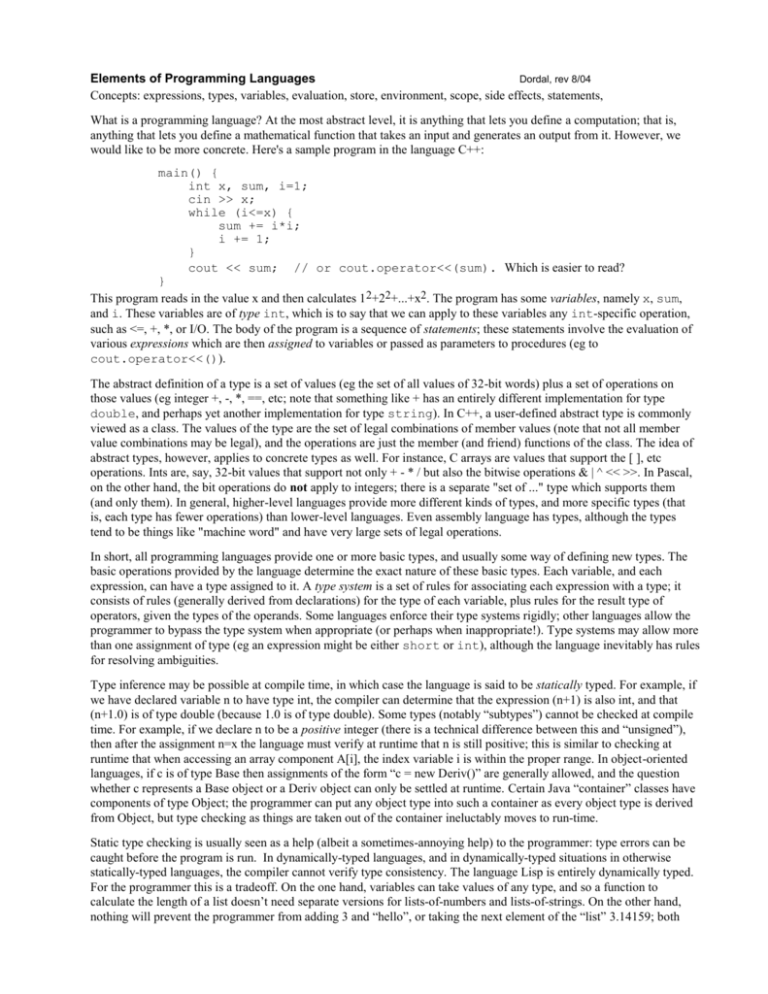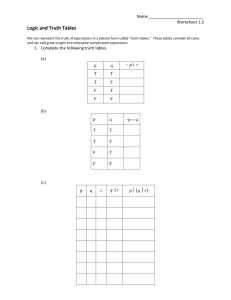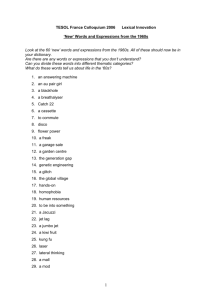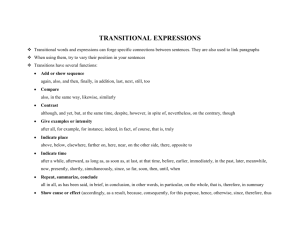programming language overview
advertisement

Elements of Programming Languages
Dordal, rev 8/04
Concepts: expressions, types, variables, evaluation, store, environment, scope, side effects, statements,
What is a programming language? At the most abstract level, it is anything that lets you define a computation; that is,
anything that lets you define a mathematical function that takes an input and generates an output from it. However, we
would like to be more concrete. Here's a sample program in the language C++:
main() {
int x, sum, i=1;
cin >> x;
while (i<=x) {
sum += i*i;
i += 1;
}
cout << sum; // or cout.operator<<(sum). Which is easier to read?
}
This program reads in the value x and then calculates 12+22+...+x2. The program has some variables, namely x, sum,
and i. These variables are of type int, which is to say that we can apply to these variables any int-specific operation,
such as <=, +, *, or I/O. The body of the program is a sequence of statements; these statements involve the evaluation of
various expressions which are then assigned to variables or passed as parameters to procedures (eg to
cout.operator<<()).
The abstract definition of a type is a set of values (eg the set of all values of 32-bit words) plus a set of operations on
those values (eg integer +, -, *, ==, etc; note that something like + has an entirely different implementation for type
double, and perhaps yet another implementation for type string). In C++, a user-defined abstract type is commonly
viewed as a class. The values of the type are the set of legal combinations of member values (note that not all member
value combinations may be legal), and the operations are just the member (and friend) functions of the class. The idea of
abstract types, however, applies to concrete types as well. For instance, C arrays are values that support the [ ], etc
operations. Ints are, say, 32-bit values that support not only + - * / but also the bitwise operations & | ^ << >>. In Pascal,
on the other hand, the bit operations do not apply to integers; there is a separate "set of ..." type which supports them
(and only them). In general, higher-level languages provide more different kinds of types, and more specific types (that
is, each type has fewer operations) than lower-level languages. Even assembly language has types, although the types
tend to be things like "machine word" and have very large sets of legal operations.
In short, all programming languages provide one or more basic types, and usually some way of defining new types. The
basic operations provided by the language determine the exact nature of these basic types. Each variable, and each
expression, can have a type assigned to it. A type system is a set of rules for associating each expression with a type; it
consists of rules (generally derived from declarations) for the type of each variable, plus rules for the result type of
operators, given the types of the operands. Some languages enforce their type systems rigidly; other languages allow the
programmer to bypass the type system when appropriate (or perhaps when inappropriate!). Type systems may allow more
than one assignment of type (eg an expression might be either short or int), although the language inevitably has rules
for resolving ambiguities.
Type inference may be possible at compile time, in which case the language is said to be statically typed. For example, if
we have declared variable n to have type int, the compiler can determine that the expression (n+1) is also int, and that
(n+1.0) is of type double (because 1.0 is of type double). Some types (notably “subtypes”) cannot be checked at compile
time. For example, if we declare n to be a positive integer (there is a technical difference between this and “unsigned”),
then after the assignment n=x the language must verify at runtime that n is still positive; this is similar to checking at
runtime that when accessing an array component A[i], the index variable i is within the proper range. In object-oriented
languages, if c is of type Base then assignments of the form “c = new Deriv()” are generally allowed, and the question
whether c represents a Base object or a Deriv object can only be settled at runtime. Certain Java “container” classes have
components of type Object; the programmer can put any object type into such a container as every object type is derived
from Object, but type checking as things are taken out of the container ineluctably moves to run-time.
Static type checking is usually seen as a help (albeit a sometimes-annoying help) to the programmer: type errors can be
caught before the program is run. In dynamically-typed languages, and in dynamically-typed situations in otherwise
statically-typed languages, the compiler cannot verify type consistency. The language Lisp is entirely dynamically typed.
For the programmer this is a tradeoff. On the one hand, variables can take values of any type, and so a function to
calculate the length of a list doesn’t need separate versions for lists-of-numbers and lists-of-strings. On the other hand,
nothing will prevent the programmer from adding 3 and “hello”, or taking the next element of the “list” 3.14159; both
these lead to run-time disaster. The language Haskell attempts to retain the programmer flexibility of Lisp while at the
same time adding static type checking; Haskell makes type inferences at compile time, and expressions of indeterminate
type are assigned to type variables. For example, a list-length function has type “list X”, where X is a type variable
meaning “any type can go here”; the type expression “list X” thus means “list of any type”.
Expressions are anything that has a value. An expression can be a variable, a constant value, or the result of an operation/
function applied to subexpressions. Expressions can be represented by trees, with the leaf nodes being variables and
constants, and the internal nodes representing operations being applied to the child nodes. For example, a+3*b+5*d can
be represented by the tree
+
/
\
+
*
/ \
/ \
a * 5
d
/ \
3
b
assuming the usual precedence and grouping rules for + and *. It is important to realize that expressions always have a
unique tree structure (assuming the programming language grammar is unambiguous!) even if the precedence and
grouping rules are implicit rather than explicit. a+3*b+5*d is, in effect, (a+(3*b))+(5*d), or, with operators written in
functional style, +(+(a, *(3,b)), *(5,d)), or in Lisp, (+ (+ a (* 3 b)) (* 5 d)).
Even with the tree there is considerable scope for variation in how subexpressions are to be evaluated, particularly when the
operators are user-defined functions and the subexpressions are thus function parameters. Here are a few common
parameter-passing conventions: call-by-value, call-by-result, call-by-value-result, call-by-reference, call-by-constant-reference, call-by-name. There is also the distinction between full evaluation (evaluate all operands at the beginning) and
short-circuit or lazy evaluation (evaluate operands only if needed, particulaly relevant for the Boolean operators and and
or). We will return to these later. For the moment, note that the following loops would fail
while (i<=max) and (A[i] <> x) do i:= i+1;
while (p!=0 && p->data != x) p = p->next;
if the Boolean evaluation were not short-circuited, and the second clause were always evaluated even when the first is
false. Evaluation of the second clause here when the first is false typically causes a run-time error.
Named values may be variables or constants. Variables represent locations in storage; the set of all such locations
constitutes the store. One can think of the store as the collection of all variables, although it is more precise to view it as
the collection of all variable locations. The environment is a mapping between (all) program names and the things they
represent. Conceptually, if a variable represents a location, then given a variable X one would first look in the
environment to find the current location LX for X, and then in the store to find the current contents of LX. If a name
represents a value that is not a variable -- that is, it represents a constant value -- then that value would be found
(conceptually) by direct lookup in the environment. In actual implementations the division into environment and store is
rarely explicit, although many environment accesses are in effect done at compile time, and store accesses correspond
most clearly to memory fetches.
Given an instance of a name, say X, programming languages usually have scope rules for deciding to which prior
declaration of X the instance refers. For example, if X has been declared both globally and locally, the "most-closelynested" rule to which most languages adhere implies that the local declaration of X is the one that is applicable:
const int X = 3;
foo (float X) {float y; y = X;}
bar () {float y; y = X;}
// this X refers to the local declaration, as a float
// this X refers to the global X, as const int 3
If the scope of a declaration can be inferred at compile time the language is said to have static scope. Scope rules are,
however, sometimes dynamic; for example, an instance of a variable might be bound to the most recent declaration
encountered at run-time. With dynamic scope, if the function bar() is called from the top level then its X refers to the
global X; however, if bar() were called by foo() then the most recent binding of X would have been the one as float.
Expressions are said to have side effects if they modify the store. The term "side effect" suggests that the primary purpose
of the expression is to represent a value; this is sometimes true only in a theoretical sense. For example, assignment
statements in C++ are expressions, but certainly the store-modification side effect is the programmer's primary purpose in
making the assignment! More traditional examples of expressions with a side effect in C++ occur in the following:
while ((c=cin.get()) != EOF) a[i++] = c;
This contains three subexpressions with side effects. First is the i++ which increments i before returning its value. A
second is the assignment (c=cin.get()) within the Boolean control expression. A third is the call to cin.get()
itself, which has as side effect a change in the state of the input file cin. Subexpressions with side effects are sometimes
Considered Dangerous, although they certainly have their uses. A classic pair of examples are the following:
if (x=0)
if (p=0)
y = 0; else y = 1/x;
cout < '\n'; else printbuf(p);
In both cases the intended Boolean condition was an equality test: x==0 and p==0 respectively. Assignment was used by
mistake, but it cannot be caught by the compiler because assignments are legitimate expressions. In both cases the "else"
clause will be executed (because the value of the Boolean test expression is 0 (because the value assigned is 0), which
represents "false" in C++), but the variable will have just been assigned the value 0 by the if "condition", with
presumably disasterous results.
A statement, or command, is then any designated program fragment that (potentially) modifies the store. In Pascal,
statements are either assignments of the form variable := expression, or are procedure calls P(expr1, ..., exprN). In C++,
any expression becomes a statement when it is terminated by a semicolon. The only expressions which it is sensible to
use as commands, though, are assignments and procedure (function) calls as the others lack side effects; executing the
command "2+2;" in C++ or Java would be legal but would have absolutely no effect.
C++ and Java have the void type. An expression of type void (typically a function call) cannot be used as a part of any
larger expression, because to do so would violate the type rules. Thus, such an expression can only be used as a
statement. In this sense, then, C++ and Java now have true procedures: "function" calls that explicitly do not return
values. In most other languages, the distinction between procedures and functions is made via syntax, not via the type
system.
A traditional program is built up of sequences of statements, connected together via control structures like while and
if. The statements modify the store in careful sequence. In the program at the beginning of this document, for example,
the store consists of x, i, sum. The body of the loop repeatedly modifies i and sum until a particular condition (i>x) is
reached. To understand such a program, the programmer must keep track of all the modifications to the store, and
understand how they interact. This approach is known as imperative programming.
The Von Neumann Architecture
The standard machine architecture, on which all the programming languages we will discuss must be implemented,
involves sequential execution of machine instructions. Memory is organized as a sequentially numbered array of bytes
(RAM); all higher-level data structures must be "mapped" onto this. The store, in particular, is an abstraction of this idea
of a series of memory locations. A classic example of a data structure that does not map very conveniently onto this
model is the dynamically-sized array; arrays need fixed allocations of memory. In order to implement variable-sized
arrays, then, the implementor must be willing to move arrays when they are resized.
Many languages have been designed with a straightforward implementation in mind. In Pascal and C, for example,
statements may involve several machine instructions but the idea of sequential execution is preserved almost unchanged.
One of our topics will be the idea that, while perhaps all data structures can be mapped onto the RAM memory model,
the sequential execution of statements is not the only programming paradigm.
Functional Programming
Functional programming is a radical alternative to traditional imperative programming. The essential feature of what is
called "functional programming" is summarized as follows [Sethi]:
The value of an expression depends only on the values of its subexpressions, if any
In particular, the value returned by a function cannot depend on any global variables, in keeping with the adage "side
effects considered harmful". Strict functional programming may even ban assignment (although some functional
languages allow some forms of assignment). Without assignment, one does not have variables (although one can have
constants and parameters). Variables, and hence the store, are a basic part of programming and it sometimes seems
impossible to do without them. However, they are not in fact essential. Without a store, though, one cannot have loops:
loops require that each time through the body of the loop the store must be changed in some way, to represent progress
through the loop. (We will see in Haskell an interesting way around this loop obstacle.) Without a store, the sequence of
execution also cannot matter: if expressions A and B do not have any side effects (which must be the case without a
store), then executing B before A must be the same as executing A;B.
Without a store, one must program entirely with expressions. Subexpressions replace the notion of statements in
sequence; the top call will be to evaluate a single expression but evaluating that expression will entail orderly progress
through various subexpressions. Recursion is used in lieu of loops. Here is a recursive version of the loop above:
int squaresum (int x) {
if (x==0) return 0;
else return x*x + squaresum(x-1);
}
Note that recursion entails naming a program fragment that would otherwise have been "anonymous". To finish off the
conversion, suppose the function read() reads an integer value and returns it. Then the program could be written as:
cout << squaresum(read());
The variable x in squaresum warrants mention. It is still a variable, so the store still is there in theory. However, we are
not using it as such: we never assign to it. In practice, x is a constant, with a value bound to it at function entry. Each
level of the recursion, however, binds x to a different value (sequentially decreasing until we reach x==0). In any one
frame of reference, x has a constant value.
Note that the main program now consists of a single expression. To evaluate the cout, we must first evaluate the
squaresum(). To evaluate the squaresum, we must first evaluate the read(). In this sense, then (and this sense only), the
notion of sequential execution still exists.








